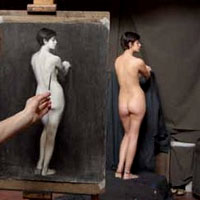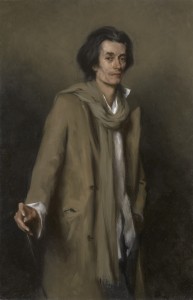 Atelier training is to be distinguished from that of an academy. The curriculum of an atelier cannot be subdivided into academic categories of elective or required course units. It is instead an integral process of educating the eye to see – contour, proportion, chiaroscuro, modelling and, ultimately, colour. From the very beginning, students draw daily from the figure model and casts. They are not required to spend time copying reproductions in the flat, but go directly to studying form under natural light in historic studios designed especially for artists.
Atelier training is to be distinguished from that of an academy. The curriculum of an atelier cannot be subdivided into academic categories of elective or required course units. It is instead an integral process of educating the eye to see – contour, proportion, chiaroscuro, modelling and, ultimately, colour. From the very beginning, students draw daily from the figure model and casts. They are not required to spend time copying reproductions in the flat, but go directly to studying form under natural light in historic studios designed especially for artists.
The method of teaching is related to the size of the atelier – some twenty students. Charles H. Cecil is thus personally able to follow the progress of each individual. Classes are limited to from six to twelve students, and an instructor regularly works alongside giving daily critiques. Students draw standing with the easel in an upright position, as they will when they eventually paint the nude and portrait in oil. They learn to compare the model and image from a distance, both for accuracy of draughtsmanship and unity of effect.
First Year Students
 Casts are drawn to the scale of life using the sight‑size method. Students work from a number of casts in charcoal each term to gain the ability of laying in proportions accurately and modelling the subtleties of chiaroscuro. They are prepared for portraiture to the scale of life by the end of the first term. At the end of the year students are introduced to portrait painting in oils using a limited palette.
Casts are drawn to the scale of life using the sight‑size method. Students work from a number of casts in charcoal each term to gain the ability of laying in proportions accurately and modelling the subtleties of chiaroscuro. They are prepared for portraiture to the scale of life by the end of the first term. At the end of the year students are introduced to portrait painting in oils using a limited palette.
The other half of the day is devoted to sight‑size figure drawing in pencil and charcoal. Pencil drawing is crucial for the understanding of line, contour and modelling. Emphasis is on seeing the drawing as a whole, rather than as a composite of separate details. Work in charcoal teaches the perception of chiaroscuro in relation to the background and leads to a broader and more painterly handling. At intervals throughout the year students are taught anatomy as they develop their skills in figure drawing.
Second & Third Year Students
 When the requisite level of draughtsmanship has been attained, second-year students concentrate on sight‑size portrait and figure painting. They learn to key their work to nature with the limited flesh palette. Students are taught the preparation of canvas and grounds, as well as the handgrinding of oil paints, and the making and use of mediums based on the analysis of historical accounts.
When the requisite level of draughtsmanship has been attained, second-year students concentrate on sight‑size portrait and figure painting. They learn to key their work to nature with the limited flesh palette. Students are taught the preparation of canvas and grounds, as well as the handgrinding of oil paints, and the making and use of mediums based on the analysis of historical accounts.
During their third year, students advance to large-scale figure painting and portrait compositions. They progressively gain a mastery of working to the scale of life with impact from a distance. At regular intervals former pupils with professional experience return to teach, thus enabling students to learn by example and receive expert critiques. Students may continue their studies for a fourth year or come back at a later date to further their training.
Art History Lectures
Throughout the year Charles H. Cecil gives weekly art history lectures on Thursday evenings. During the first term Cecil concentrates on the Italian Renaissance from its origins in the art of Giotto to the era of Michelangelo. The important masterworks of Tuscany are discussed, and students are encouraged to see the originals in situ.
The lectures during the second term trace the development of oil painting in the sixteenth and seventeenth centuries. Particular emphasis is placed on Titian, Rubens, Van Dyck, Velázquez and Rembrandt. Large-scale decorative compositions are analyzed as well as portraiture.
The third term is devoted to comparing the above masters to their successors in the British and French Schools, leading to Sargent and his contemporaries. Works using the sight‑size method are demonstrated and give the student an art historical perspective essential to atelier training.
Term Dates 2023 / 2024
The academic year runs from October to June with breaks at Christmas and Easter. The full studio training is three years. Under certain circumstances we may accept students on an annual or termly basis. Sessions are held from 9 am-noon and 1-4 pm weekdays. There is a lecture every Thursday at 7:30 pm and a sketch class each Tuesday from 6:00-8:00 pm. The Tuition fees below include 22% IVA.
| TERM | START DATE | END DATE | TUITION (€) |
|---|---|---|---|
| Autumn | 2nd October 2023 | 15th December 2023 | € 3900 |
| Spring | 8th January 2024 | 22nd March 2024 | € 3900 |
| Summer | 15th April 2024 | 21st June 2024 | € 3900 |
Term Dates 2024 / 2025
| TERM | START DATE | END DATE | TUITION (€) |
|---|---|---|---|
| Autumn | 30th September 2024 | 20th December 2024 | € 3900 |
| Spring | 13th January 2025 | 28th March 2025 | € 3900 |
| Summer | 22nd April 2025 (Tuesday start allows for Easter Monday) | 27th June 2025 | € 3900 |